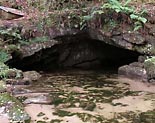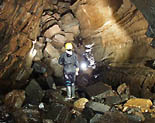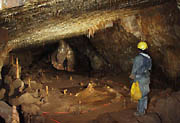 |
| |
Welcome !
~
Ogof Ffynnon Ddu (pronounced: oh-gof-fun-on-thee in Welsh), is the deepest
and 3rd longest cave in the UK. It lies deep under a grassy,
rocky hillside in the Upper Swansea Valley in South Wales. The underground river
roars and tumbles along its deepening course, great sandy chambers stand still
and silent, and the delicate stalactites drip quietly, and all in total darkness,
even as you read this, even as we sleep. High above, sheep graze the slopes and
sometimes Buzzards and even Red Kites can be seen circling overhead.
| |

|
A brief history:
~ OFD was
discovered in 1946 by Peter
Harvey and Ian Nixon. The South Wales Caving Club was formed
at that time. Peter was for a long time our Club President, and
only stopped caving around 2006 in his mid eighties.
Here is a brief account of the discovery and early exploration:
High
on the slopes of Fan Gyhirych it is raining. Well,
this is Wales after all. Several streams rush down into a huge soggy peat bog,
dotted with marsh grasses and reeds. After slower progress through this obstacle
the Byfre Fechan emerges, enlivened and more acidic than before. It then promptly
sinks into the mud, rocks and flood debris that is Pwll Byvre and discovers a
deep band of Carboniferous Limestone to get its teeth into. The local sheep, having
jumped over the stream to reach another juicy patch of grass, carry on chewing
and don't give it another thought.
One thousand feet lower, in the Tawe valley,
a wide rock arch disgorges a strong and languid river, dark and
rich with secrets. This is the Ffynnon Ddu, the Black Spring.
After rain this resurgence swells and boils as the underground
river rushes into daylight. In heavy flood, unable to cope with
the pressure, the river finds release by bursting out from rocky
crevasses in the woods and fields nearby.
top |
|
|
|
| The Resurgence |
Click for a
more detailed survey | Boulder
Chamber |
Early Explorers.
In the summer of 1946, Peter and Ian, fascinated by this
promising but impenetrable resurgence, turned their attention to these occasional
springs, and began to dig . . .
What
they found was what we now call OFD l, a sporting
and sinuous river cave, sculpted out of dark limestone. Dangerous in flood, the
clean-washed high river passages are a joy to explore, as long as you know how
to climb up to the high level dry passages if need be! Delighted by their new
discovery, early members of SWCC were stopped in their tracks by a huge boulder
pile about half a mile into the cave. After
much hard work, rock falls and determined wriggling, they broke through Boulder
Chamber, only to be faced with a deep and ominous sump pool. By now it was the
1960's, and cave diving was very much in its infancy. The first underwater visitors
were still at that time using "bottom walking" techniques with lead
boots and heavy oxygen re-breathing apparatus. Fortunately the cross-over was
beginning to diving with fins, and this allowed the early explorers much more
freedom and flexibility.
|
|
|
|
|
| Diving in Dip Sump |
OFD ll Streamway | Near
Top Entrance | | |
The Connection. Dip
Sump was finally passed in 1966 by pioneering cave divers Charles
George and John Osborne, who even dived carrying a ladder through,
so that they could climb out at Shower Aven! The way was open
into the long sought-after upper reaches of the mainstream, OFD
ll. Month after month, longer and longer trips were made
upwards and upwards as the cave slowly revealed her secrets. Some
of the hardest work was carrying scaffold poles up the mainstream
and the scaling of Maypole Inlet. Finally in September 1967, having
entered through the Cwm Dwr entrance
(discovered in 1963), they came to within a few feet of the surface,
having traversed two miles of passage and climbed up some 700
ft, passing underneath what are now our Club cottages.
After a combination of hammer blows and
early radio-communication with the surface, the underground party
dug upwards pulling down soil, mud and boulders! The Top Entrance
(E)
was open, and with it a classic through trip. **
In the rush of exploration that followed, the connection to OFD
lll
was
made, along with many more miles of passages.
More recently the discovery of the Northern Lights has filled
a blank space on the survey, but there is surely more to find.
Playground. Edge your way along
daunting high-level traverses, chimney down winding canyons, slither through narrow
passages, post yourself backwards through the Letter Box, wander through broad
tunnels, hold your breath as you jump into deep plunge pools or stand in awe in
front of beautiful calcite columns. This cave has it all. The
underground river roars and tumbles along its deepening course, it is the system's
backbone as well as its creator. And if you sit alone for a while by the Gothic
Sump, you will hear voices amongst the gloops, drips and splashes.
Back on the surface, the sheep are still chewing contentedly, and still don't
think to ask where the stream goes.
~
The system is now 308
meters (1010 ft) deep, and has around 59 km (37 miles) of passages ~
Some
Welsh names:
Ogof
~ Cave. Ffynnon ~ Spring.
Ddu ~ Black.
Fan Gyhirych
~ Gyhirych Mountain. Byvre
Fechan ~ Little Byvre (stream).
Pwll
Byvre ~ Byvre Pool (stream sink).
Cwm Dwr ~ Valley
of Water.
** Among those present at the
Top
Entrance breakthrough in 1967 were: Hywell Ball, Noel Christopher,
Paul Deakin, Colin Fairburn, Bruce Foster, Peter Harvey, Mike
Holhead, Clive Jones, Bill Little, Henry Mares, Terry Moon, Paddy
and Susan O'Reilly, John Osborne, Jem Rowland, Rod Stewart and
Clive Westlake.
Would
you like to follow in their footsteps? Let's go!
Read Tony
Knibbs' and Eric Inson's reminiscences top |
|
|
The virtual tour (hints
and tips):
~ My aim is to give you a real caver's eye view as you explore. To find your way, you will
need to click on the link(s)
hidden within each picture, to move ahead. As a clue,
two small dots .. at
the bottom left of any page indicate that there is more than one way to go. To
date there are around 350 interlinked pages available, showing many of the
actual views that you would get during 10 - 12 hours of real caving trips in this
vast system. See if you can find
the elusive link from l to ll or hunt for
the key to the beautiful Columns
formations, or make your way over the scary traverses
to Smith's Armoury in OFD lll.
~ Along
the way there are a number of round trips, large and small, and some blind
alleys too (just like the real thing!), and the famous Through
Trips (in both directions). You may also find yourself getting lost, or
returning to where you started via different route! With perseverance it is possible
to see it all. To assist the feeling of realism, you won't find lots of distracting
menus on each page. Just photographs along with some helpful descriptions, and
the occasional map to guide you.
~ I've
designed the photographs to appear as fast as possible, while still giving
good detail, and you will notice that if you visit any page a second time, the
picture will appear almost instantaneously. (If it doesn't, check that your browser's
cache is set to check automatically for visited pages.) You probably won't
cover all the possible routes in your first visit, but if you return, you
will find that you will be able to quickly resume your exploration
from where you left off. top |
|

| |
Happy caving - take care of the natural environment, yourself and your
fellow explorers, and do let me know in the Visitor's Book, how you got on!
*A
prophecy? I was somewhat humbled, a while ago, to read in our Club's 50th Anniversary
Publication (1996), the following from Peter Harvey: "So good luck! However
remember, things never remain the same and it could be that in 2046 very few people
will actually go caving but will experience it electronically sitting at home
in some form of virtual reality ...... so enjoy your caving while you can"
~ So, do come and see it for real - come and visit the South
Wales Caving Club.
Weather
Warning - In the real cave the Mainstream and attempts
to do the Through Trip can be dangerous in wet or unsettled weather. Always check
the forecast, get local advice, and don't go there if in any doubt.
Check
the weather here.
top |
Credits
~
Felicity, Tom, Sue,
Noel, Rick, Leif, Ingy, Helena, Cecilia, Eric, Martin and Volker for excellent flashgun
and modelling assistance (and anyone else who has ever assisted!)
~ The South Wales
Caving Club and Elsie for their support, and permission to reproduce
the cave survey, to Eric for taking us to the columns and to Clive
Westlake for information about the opening of Top Entrance.
~
Martyn Farr (cave diver extrordinare) for permission to
use some of his underwater shots where I dare not go.
www.farrworld.co.uk ~
And to the CCW who take care of some of the land overlying
the cave system:

| |
© Peter Collings-Wells 2003-2020 |
| | | |










